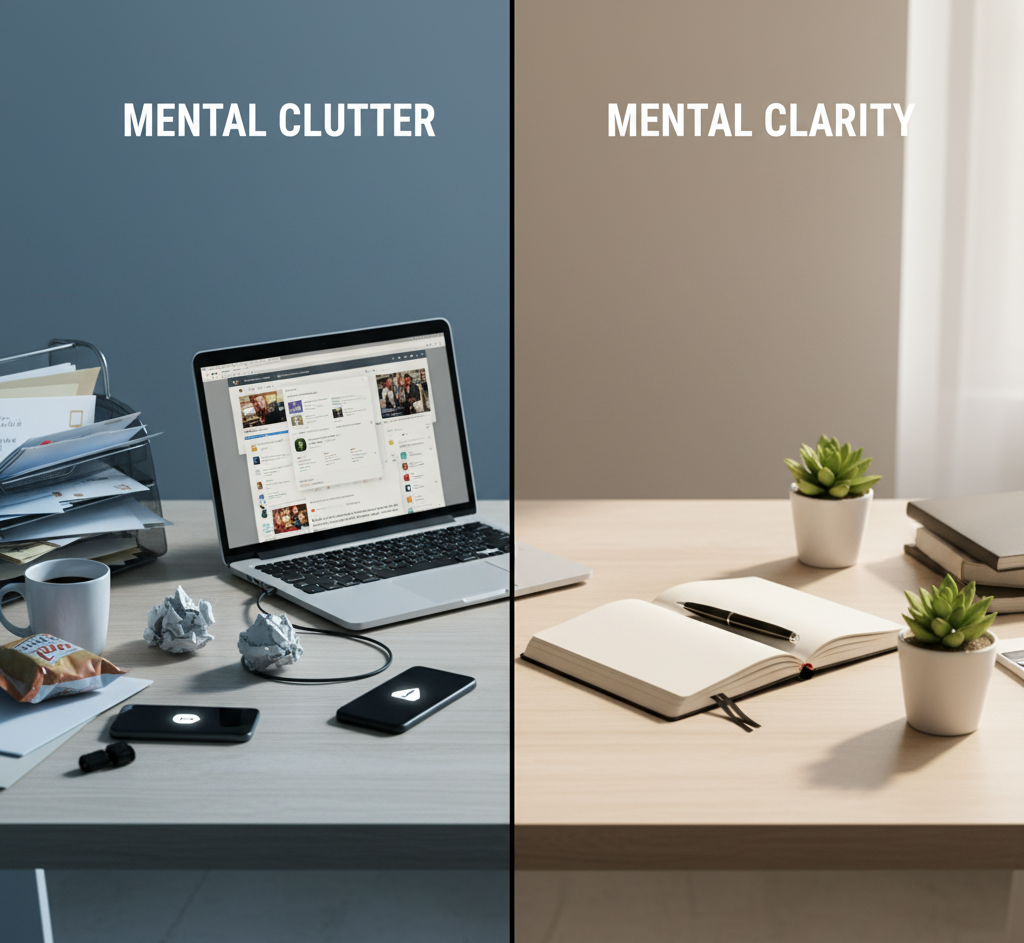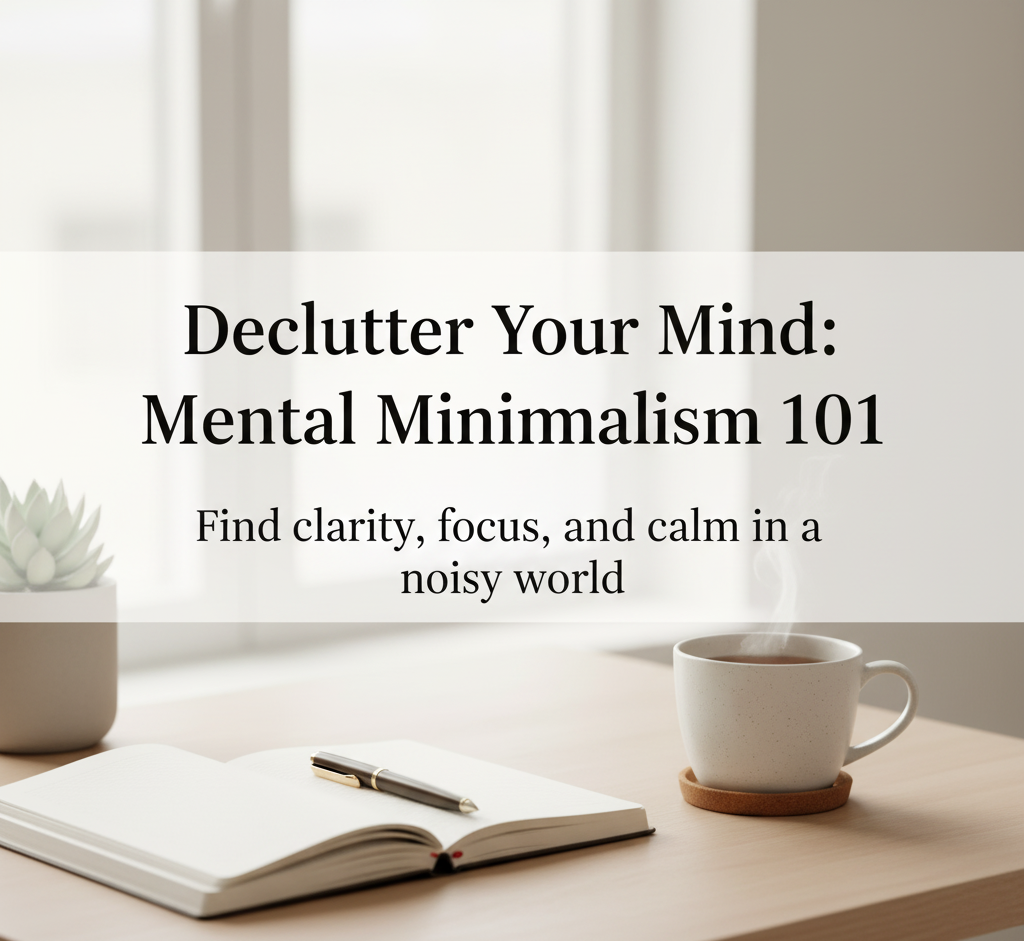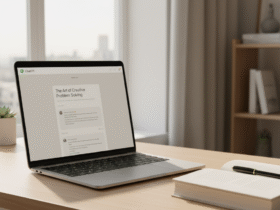Have you ever sat down to focus—only to find your mind juggling a dozen tabs at once? That never-ending list, that half-read email, that thing you forgot to add to your grocery cart? It’s not just you. Most of us live with constant background noise in our minds, making even simple tasks feel heavier than they should.
I used to think I had a “productivity problem.” Turns out, what I really had was mental clutter. The endless information, notifications, and decisions were leaving me mentally exhausted before the day even began.
That’s where mental minimalism comes in. Just like decluttering your home, it’s about creating space—space to think, breathe, and focus on what truly matters. In this post, we’ll explore what mental minimalism really means, how to declutter your mind without renouncing modern life, and practical steps you can start today to restore calm and clarity.
What Is Mental Minimalism?
Mental minimalism isn’t about emptying your mind or living in total silence. It’s about filtering the unnecessary so your thoughts can move with ease. Think of it as spring cleaning for your mental space.
When your brain is overloaded with inputs—tasks, worries, goals, notifications—it struggles to prioritize. You start reacting instead of choosing. That’s the mental equivalent of a messy desk: everything’s there, but finding what matters takes effort.
Key takeaway: Mental minimalism helps you shift from chaos to clarity by focusing only on what deserves your energy.
The Core Principles of Mental Minimalism
- Intentional Attention – Focus on one thing fully instead of scattering your attention across ten.
- Simplified Inputs – Reduce unnecessary information and digital noise.
- Emotional Lightness – Let go of thoughts that don’t serve your peace.
- Purposeful Reflection – Regularly pause to reassess what’s worth keeping in your mental space.
When practiced consistently, these principles form the foundation for a calmer, more deliberate life.
Why Mental Clutter Happens (and How It Sneaks In)

You might not even notice when mental clutter builds up. It often starts small—one extra commitment, one late-night scroll, one “I’ll deal with that later.” Before you know it, your brain becomes an overcrowded inbox.
Here are some of the most common culprits:
- Constant connectivity – You never fully “log off.”
- Overcommitting – Saying yes to things that drain more than they give.
- Unprocessed emotions – Carrying unresolved stress from work or relationships.
- Information overload – Reading, listening, and watching more than your mind can digest.
Key takeaway: Mental clutter accumulates quietly—until it steals your ability to focus, create, and rest.
How to Start Decluttering Your Mind
So, how do you actually start clearing mental clutter? It’s not about deleting every thought—it’s about organizing your inner world so it supports you instead of overwhelming you.
Let’s walk through a few practical steps.
Step 1: Identify What’s Taking Up Space
Before you can declutter, you need to see what’s filling your mental space. Ask yourself:
- What worries or thoughts pop up most often?
- What do I think about that doesn’t actually matter long-term?
- Which commitments or habits no longer serve me?
Write them down. Getting them out of your head and onto paper is powerful—it transforms vague pressure into something you can manage.
Pro tip: I like using Notion or a simple notebook for this “mental inventory.” It’s not about structure; it’s about visibility.
Step 2: Simplify Your Digital Inputs
Digital clutter is one of the biggest contributors to mental chaos. Every ping, post, and email grabs a piece of your attention.
Try this quick detox:
- Turn off non-essential notifications.
- Unsubscribe from newsletters you never read.
- Set time windows for checking messages instead of being constantly available.
You’ll be amazed how much lighter your mind feels once you stop feeding it every digital crumb.
Key takeaway: Every notification you silence is one thought you don’t have to carry.
Step 3: Practice Single-Tasking
Multitasking sounds efficient—but in reality, it splits your focus and drains your energy faster. When you give your full attention to one thing, your mind relaxes. It knows what to do, and everything else can wait.
Try this:
- Choose one task.
- Close all unrelated tabs.
- Set a 25-minute timer (Pomodoro-style).
- Focus deeply, then rest fully.
It’s deceptively simple but incredibly grounding. Over time, this practice becomes the foundation of mental minimalism: doing one thing well, with calm attention.
Step 4: Declutter Emotionally

Mental clutter isn’t just about thoughts—it’s also about emotions that linger unprocessed. Anxiety, guilt, resentment—all these take up real space in your mind.
A few ways to release them:
- Journaling: Write down what’s bothering you, even if it feels messy.
- Movement: Walk, stretch, or breathe deeply to release mental tension.
- Boundaries: Say no to energy-draining commitments.
Sometimes, clarity comes not from thinking harder but from feeling fully and letting go.
Key takeaway: Emotional clarity is mental clarity. Don’t organize your thoughts—lighten your heart first.
Step 5: Create Mental White Space
Just as your home needs empty shelves, your mind needs blank space too. Constant stimulation leaves no room for reflection, creativity, or peace.
Try creating intentional mental white space by:
- Taking short breaks between tasks (without reaching for your phone).
- Scheduling “nothing” time each week.
- Spending 10 minutes a day in quiet—just noticing your breath.
I call this “mental breathing room.” You might feel restless at first, but soon it becomes your reset button.
Living the Minimal Mindset

Mental minimalism isn’t a one-time cleanup—it’s a way of approaching life. Over time, you’ll start noticing what feels heavy and what feels freeing. You’ll choose simplicity, not as deprivation, but as liberation.
Here’s what that might look like day to day:
- You check your phone with intention, not impulse.
- You say no without guilt.
- You focus on the few things that genuinely move you forward.
Key takeaway: A minimalist mind doesn’t lack depth—it gains direction.
My Own Experience with Mental Decluttering
There was a time when I measured productivity by how many tasks I could fit into a day. The result? A scattered mind, constant fatigue, and zero satisfaction.
When I started applying mental minimalism, it wasn’t an overnight fix. But slowly, the fog lifted. My days felt clearer, and my work became deeper. I realized: clarity is not found in doing more—it’s found in doing less, better.
That shift changed everything.
Conclusion: Start Small, Feel the Shift
You don’t need to overhaul your entire life to start decluttering your mind. Begin with one small step—turn off one notification, take one mindful pause, or write one list to empty your thoughts.
Over time, these little acts of simplification accumulate into something profound: peace of mind.
So next time your mind feels crowded, remember—you have the power to clear space for what truly matters.
If you’d like to go deeper, check out my earlier article, The Art of Doing Less: How to Work Smarter, Not Harder — it’s the perfect next step for building a calmer, more focused life.





